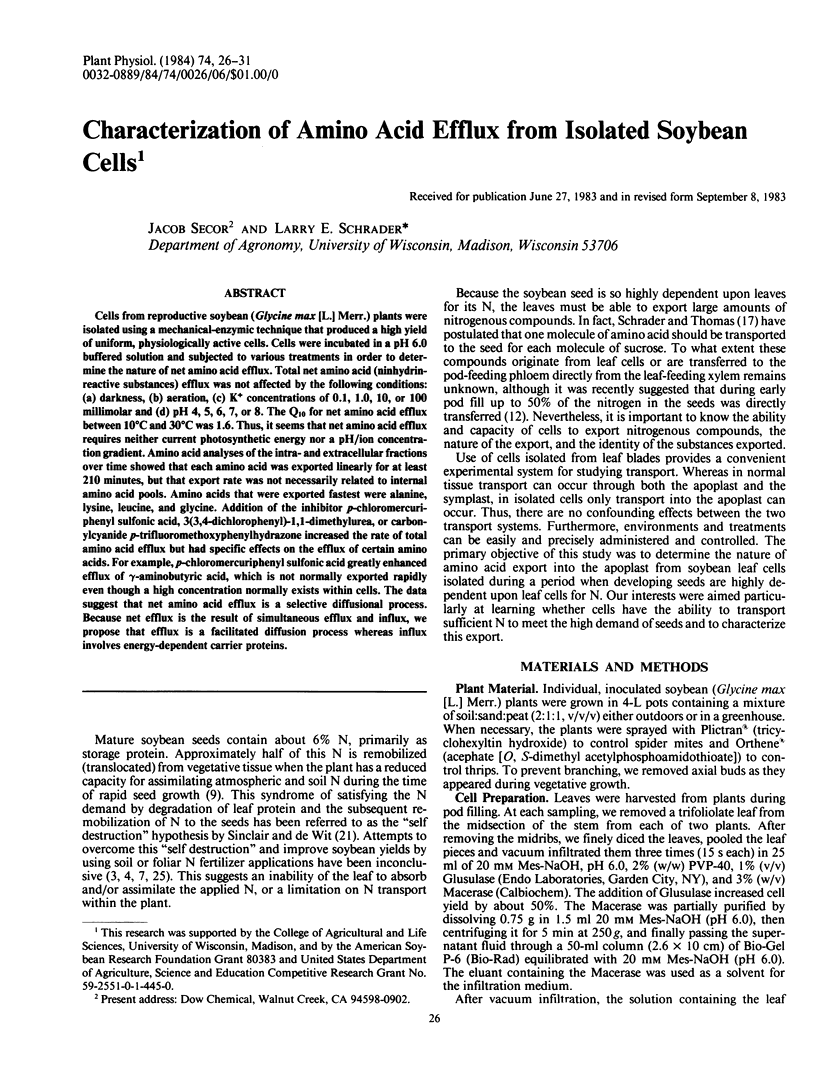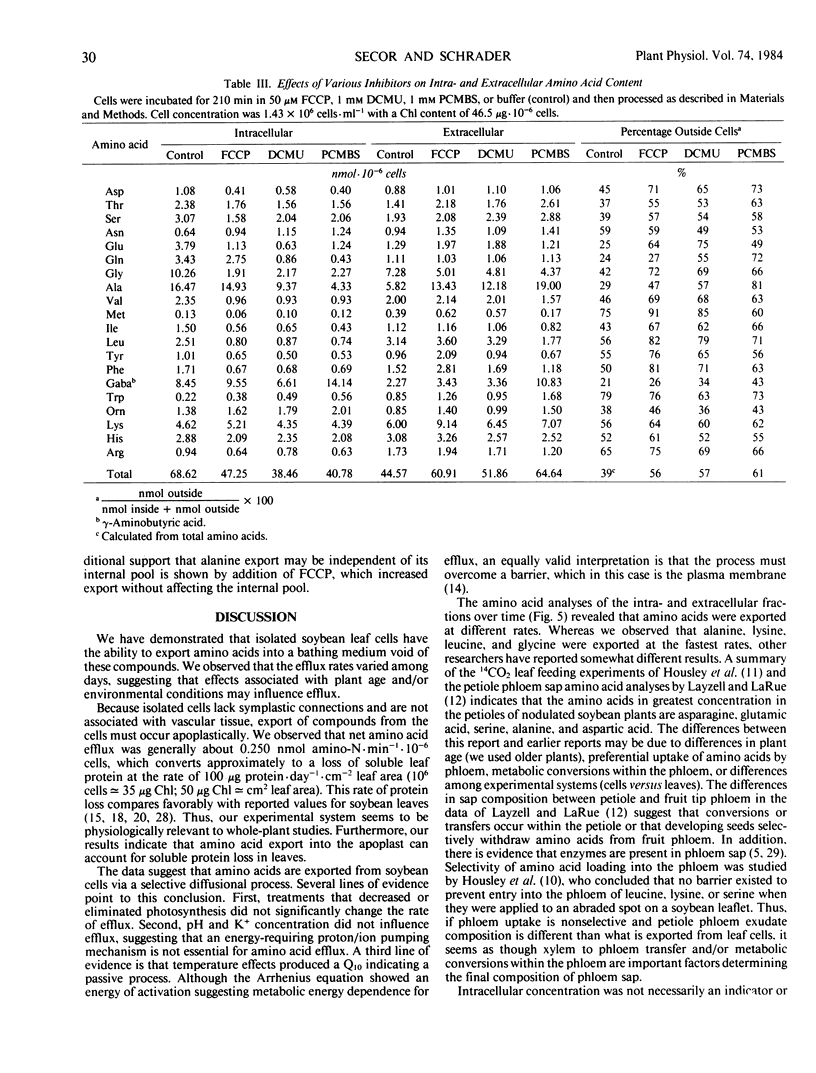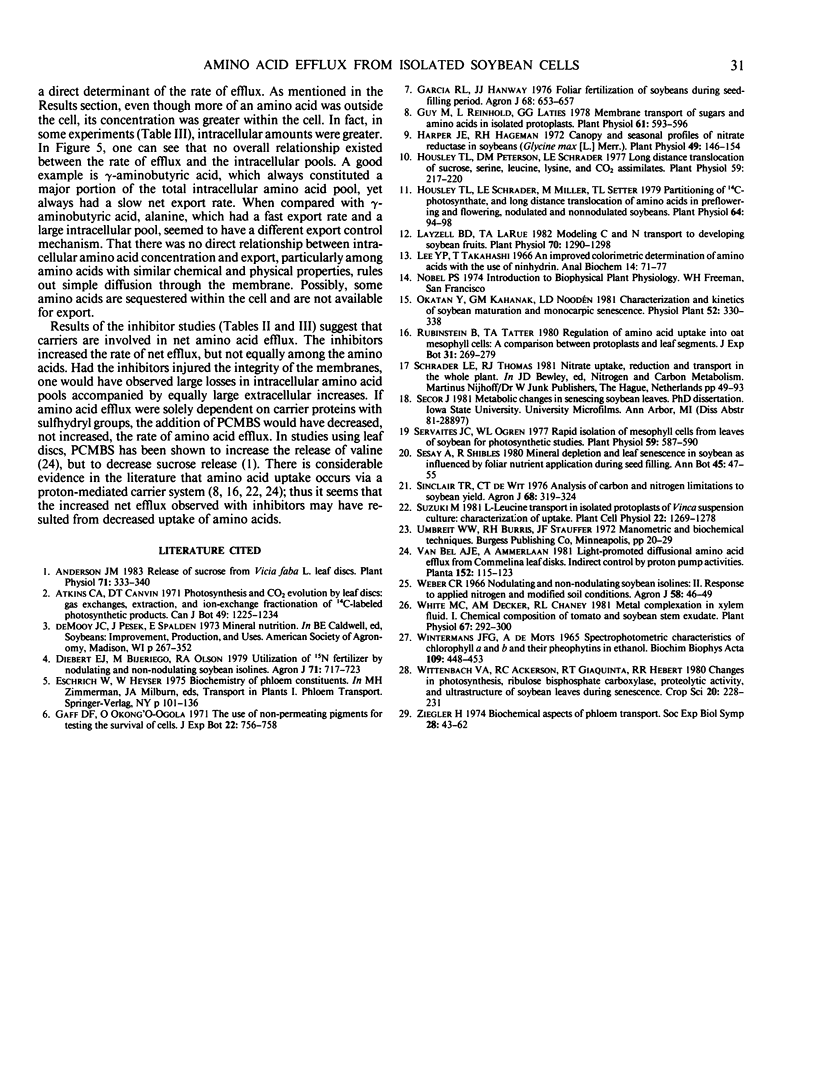Abstract
Cells from reproductive soybean (Glycine max [L.] Merr.) plants were isolated using a mechanical-enzymic technique that produced a high yield of uniform, physiologically active cells. Cells were incubated in a pH 6.0 buffered solution and subjected to various treatments in order to determine the nature of net amino acid efflux. Total net amino acid (ninhydrinreactive substances) efflux was not affected by the following conditions: (a) darkness, (b) aeration, (c) K+ concentrations of 0.1, 1.0, 10, or 100 millimolar and (d) pH 4, 5, 6, 7, or 8. The Q10 for net amino acid efflux between 10°C and 30°C was 1.6. Thus, it seems that net amino acid efflux requires neither current photosynthetic energy nor a pH/ion concentration gradient. Amino acid analyses of the intra-and extracellular fractions over time showed that each amino acid was exported linearly for at least 210 minutes, but that export rate was not necessarily related to internal amino acid pools. Amino acids that were exported fastest were alanine, lysine, leucine, and glycine. Addition of the inhibitor p-chloromercuriphenyl sulfonic acid, 3(3,4-dichlorophenyl)-1,1-dimethylurea, or carbonylcyanide p-trifluoromethoxyphenylhydrazone increased the rate of total amino acid efflux but had specific effects on the efflux of certain amino acids. For example, p-chloromercuriphenyl sulfonic acid greatly enhanced efflux of γ-aminobutyric acid, which is not normally exported rapidly even though a high concentration normally exists within cells. The data suggest that net amino acid efflux is a selective diffusional process. Because net efflux is the result of simultaneous efflux and influx, we propose that efflux is a facilitated diffusion process whereas influx involves energy-dependent carrier proteins.
Full text
PDF





Selected References
These references are in PubMed. This may not be the complete list of references from this article.
- Anderson J. M. Release of Sucrose from Vicia faba L. Leaf Discs. Plant Physiol. 1983 Feb;71(2):333–340. doi: 10.1104/pp.71.2.333. [DOI] [PMC free article] [PubMed] [Google Scholar]
- Guy M., Reinhold L. Membrane transport of sugars and amino acids in isolated protoplasts. Plant Physiol. 1978 Apr;61(4):593–596. doi: 10.1104/pp.61.4.593. [DOI] [PMC free article] [PubMed] [Google Scholar]
- Harper J. E. Canopy and Seasonal Profiles of Nitrate Reductase in Soybeans (Glycine max L. Merr.). Plant Physiol. 1972 Feb;49(2):146–154. doi: 10.1104/pp.49.2.146. [DOI] [PMC free article] [PubMed] [Google Scholar]
- Housley T. L., Peterson D. M., Schrader L. E. Long distance translocation of sucrose, serine, leucine, lysine, and carbon dioxide assimilates: I. Soybean. Plant Physiol. 1977 Feb;59(2):217–220. doi: 10.1104/pp.59.2.217. [DOI] [PMC free article] [PubMed] [Google Scholar]
- Housley T. L., Schrader L. E., Miller M., Setter T. L. Partitioning of C-photosynthate, and long distance translocation of amino acids in preflowering and flowering, nodulated and nonnodulated soybeans. Plant Physiol. 1979 Jul;64(1):94–98. doi: 10.1104/pp.64.1.94. [DOI] [PMC free article] [PubMed] [Google Scholar]
- Layzell D. B., Larue T. A. Modeling C and N transport to developing soybean fruits. Plant Physiol. 1982 Nov;70(5):1290–1298. doi: 10.1104/pp.70.5.1290. [DOI] [PMC free article] [PubMed] [Google Scholar]
- Servaites J. C. Rapid isolation of mesophyll cells from leaves of soybean for photosynthetic studies. Plant Physiol. 1977 Apr;59(4):587–590. doi: 10.1104/pp.59.4.587. [DOI] [PMC free article] [PubMed] [Google Scholar]
- White M. C. Metal Complexation in Xylem Fluid : I. CHEMICAL COMPOSITION OF TOMATO AND SOYBEAN STEM EXUDATE. Plant Physiol. 1981 Feb;67(2):292–300. doi: 10.1104/pp.67.2.292. [DOI] [PMC free article] [PubMed] [Google Scholar]
- Wintermans J. F., de Mots A. Spectrophotometric characteristics of chlorophylls a and b and their pheophytins in ethanol. Biochim Biophys Acta. 1965 Nov 29;109(2):448–453. doi: 10.1016/0926-6585(65)90170-6. [DOI] [PubMed] [Google Scholar]
- Ziegler H. Biochemical aspects of phloem transport. Symp Soc Exp Biol. 1974;(28):43–62. [PubMed] [Google Scholar]


